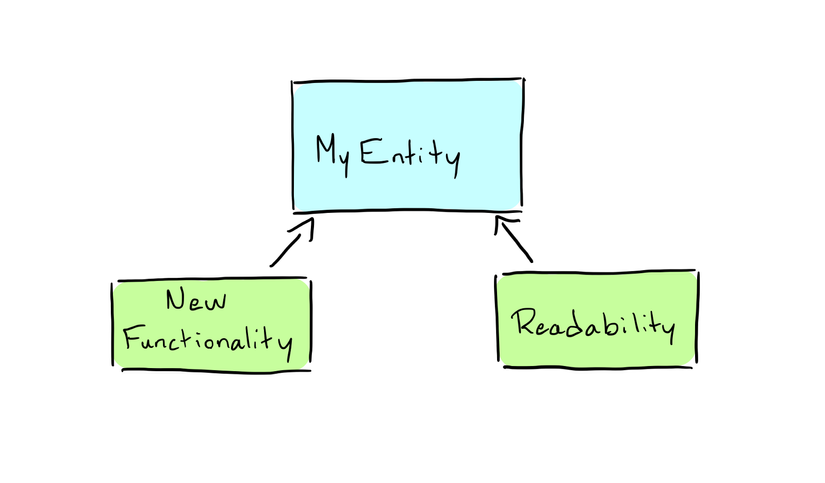Nếu
như với ARC sẽ giúp tăng hiệu năng ứng dụng của bạn hơn thì Extension
sẽ giúp code của bản trở nên dễ dàng đọc hơn (clean code)


1. Extension là gì?
Trong swift Extension thường được sử dụng những nơi mà bạn muốn thêm các hàm mà không có quyền truy cập vào source code. Ví dụ như bạn muốn mở rộng Int có sẵn của Swift bạn có thể làm như sau :extension Int {
func multiply(by multiplier: Int) -> Int {
return self * multiplier
}
}
10.multiply(by: 2)
// Returns 20
2. Ví dụ tiện lợi của việc dùng Extension
Ở đây chúng ta sẽ tiền hành xây dựng một class Binary Search Tree.Bước 1: Xây dựng Protocol
Binary Search Tree là một cấu trúc dữ liệu dừng để lưu trữ và tìm kiếm dữ liệu. Nó dựa vào hoạt động của các Node, là nơi lưu trữ giá trị và tham chiếu tới các node khác của tree. Ngoài ra tree cũng có một số phương thức như add, remove, find dữ liệu trong cấu trúc. Giờ chúng ta bắt đầu với việc tạo ra 2 protocolprotocol SearchTree {
associatedtype DataType: Comparable
func add(_ data: DataType) -> Bool
func contains(_ data: DataType) -> Bool
func find(_ data: DataType) -> DataType?
func delete(_ data: DataType) -> DataType?
func remove(_ data:DataType) -> Bool
}
protocol BinaryNode {
associatedtype DataType: Comparable
var value: DataType { get set }
var parent: Self? { get set }
var left: Self? { get set }
var right: Self? { get set }
var isLeaf: Bool { get }
}
extension BinaryNode {
var isLeaf: Bool {
return self.left == nil && self.right == nil
}
}
SearchTree chỉ định ra
những hàm mà Search Tree sẽ triển khai, và cũng chỉ định ra kiểu của dữ
liệu chúng ta chọn để lữu trữ trong tree phải implement Comparable protocol.
BinaryNode protocol chỉ định các thuộc tính cần để biểu diễn node của tree mà chúng ta có thể xử lý và tính toán.Bước 2: Implement các protocol
Tạo ra class implement các phương thức trong protocol ở trên :class BST<DataType: Comparable>: SearchTree {
private typealias NodeType = BSN<DataType>
private var root: NodeType?
init(rootValue: DataType) {
self.root = NodeType(value: rootValue)
}
init(rootValue: DataType, leftTree: BST, rightTree: BST) {
self.root = NodeType(value: rootValue, left: leftTree.root, right: rightTree.root)
}
private init(rootNode: NodeType) {
self.root = rootNode
}
func add(_ data: DataType) -> Bool {
return false
}
func contains(_ data: DataType) -> Bool {
return false
}
func find(_ data: DataType) -> DataType? {
return nil
}
func delete(_ data: DataType) -> DataType? {
return nil
}
func remove(_ data:DataType) -> Bool {
return false
}
private final class BSN<DataType: Comparable>: BinaryNode {
var value: DataType
var parent: BSN<DataType>?
var left: BSN<DataType>?
var right: BSN<DataType>?
init(value: DataType) {
self.value = value
}
init(value: DataType, left: BSN?, right: BSN?) {
self.value = value
self.left = left
self.right = right
}
}
}
Bước 3: Refactor sử dụng Extension
Thực chất Extension không được sinh ra để giải quyết vấn đề code dễ đọc hơn nhưng chúng ta có thể sử dụng theo cách này như một hiệu ứng phụ của nó.class BinarySearchTree<DataType: Comparable> {
fileprivate typealias NodeType = BinarySearchNode<DataType>
private var root: NodeType?
init(rootValue: DataType) {
self.root = NodeType(value: rootValue)
}
init(rootValue: DataType, leftTree: BinarySearchTree, rightTree: BinarySearchTree) {
self.root = NodeType(value: rootValue, left: leftTree.root, right: rightTree.root)
}
private init(rootNode: NodeType) {
self.root = rootNode
}
}
extension BinarySearchTree: SearchTree {
func add(_ data: DataType) -> Bool {
return false
}
func contains(_ data: DataType) -> Bool {
return false
}
func find(_ data: DataType) -> DataType? {
return nil
}
func delete(_ data: DataType) -> DataType? {
return nil
}
func remove(_ data:DataType) -> Bool {
return false
}
}
private extension BinarySearchTree {
final class BinarySearchNode<DataType: Comparable>: BinaryNode {
var value: DataType
var parent: BinarySearchNode<DataType>?
var left: BinarySearchNode<DataType>?
var right: BinarySearchNode<DataType>?
init(value: DataType) {
self.value = value
}
init(value: DataType, left: BinarySearchNode?, right: BinarySearchNode?) {
self.value = value
self.left = left
self.right = right
}
}
}
Comments
Post a Comment